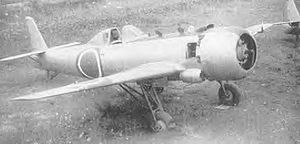Nakajima Ki-115 Video - Scale model
|
|
Nakajima Ki-115
Ki-115 Tsurugi

Picture - A scale model of the Nakajima Ki-115 Tsurugi
Role: Kamikaze aircraft
Manufacturer: Nakajima Aircraft Company
First flight: June 1945
Retired: 15 August 1945 (end of war)
Status: retired
Primary users: Imperial Japanese Army Air Force
Imperial Japanese Navy Air Service
Produced: 104 or 105
The Nakajima Ki-115 Tsurugi (å£ "Sword") was a one-man kamikaze aircraft developed by the Imperial Japanese Army Air Force in the closing stages of World War II in late 1945. The Imperial Japanese Navy called this aircraft TÅka (è¤è±, "Wisteria Blossom").
Historical context
The aircraft's intended purpose was to be used in kamikaze attacks on United States shipping and the invasion fleet expected to be involved in the invasion of Japan, Operation Downfall, which in the end did not take place.
Because the Japanese High Command thought that Japan did not have enough obsolete aircraft to use for kamikaze attacks, it was decided that huge numbers of cheap, simple suicide planes should be constructed quickly in anticipation for the invasion of Japan.
Construction
The aircraft was very simple, being made from "non-strategic" materials (mainly wood and steel). To save weight, it was to use a droppable take-off gear (there was to be no landing), so a simple welded steel tube undercarriage was attached to the aircraft . This, however, was found to give unmanageable ground-handling characteristics, so a simple shock absorber was then incorporated. The cross section of the fuselage was circular and not elliptical as were most planes of this size and type; such a fuselage was easier to make.
Tsurugi had the instrument panel with some flight instruments; rudder pedals in addition to the rudder lever and also a place for a radio. Flight controls included both ailerons and (in production versions) flaps.
The Ki-115 was designed to be able to use any engine that was in storage for ease of construction and supply, and to absorb Japan's obsolete stocks of engines from the 1920s and 1930s. The initial aircraft (Ki-115a) were powered by 858 kW (1,150 hp) Nakajima Ha-35 radial engines. It is not known if any other engine was ever actually fitted.
After testing the first production aircraft were fitted with the improved undercarriage and two rocket units. These may have assisted with take-off or may have been designed for the final acceleration towards the target.
Performance

Picture - A Ki-115 shortly after the war, with its propeller removed to prevent unauthorized flight
The aircraft had a top speed of 550 km/h (342 mph) and could carry up to an 800 kg (1,760 lb) bomb, enough to split a warship in two. However, it had no weapons to defend itself on the way, so would have been an easy target for the enemy fighter aircraft.
The controls were crude, the visibility terrible, and the performance abysmal. Tsurugi had very poor take-off and landing performance and could not be safely flown by anyone other than experienced pilots. There were fatal crashes during testing and training. However new, better versions with improved controls and better visibility were under intensive development. The Japanese High command had plans to construct some 8,000 per month in workshops all across Japan.
The war, however, ended before they could be used. Individually, they would have been rather inefficient weapon, but used in waves of hundreds or thousands they could have been quite destructive.
Survivors
The only surviving instance of this aircraft is at the Garber Facility of the National Air and Space Museum, in disassembled condition.
Variants
Ki-115 Tsurugi: Single-seat suicide attack aircraft. production version.
Ki-230: Single-seat suicide attack aircraft. projected version, none built.
Specifications
Data from Japanese Aircraft of the Pacific War
General characteristics
Crew: One, pilot
Length: 8.55 m (28 ft 0â
in)
Wingspan: 8.60 m (28 ft 2½ in)
Height: 3.30 m (10 ft 10 in)
Wing area: 12.4 m² (133.47 ft²)
Empty weight: 1,640 kg (3,616 lb)
Loaded weight: 2,580 kg (5,688 lb)
Max takeoff weight: 2,880 kg (max overload with 800 kg bomb) (6,349 lb)
Powerplant: 1x Nakajima Ha-35 Type 23 radial engine (provision for two rocket accelerators), 860 kW (1,150 hp)
Performance
Maximum speed: 550 km/h (297 kn, 342 mph) at 2,800 m (9,200 ft)
Cruise speed: 300 km/h (162 kn, 186 mph)
Range: 1,200 km (648 nmi, 746 mi)
Armament
Bombs: 1 x 250 kg (551 lb), 500 kg (1,102 lb), or 800 kg (1,764 lb) bomb
Bibliography
Francillon, Ph.D., René J. Japanese Aircraft of the Pacific War. London: Putnam & Company Ltd., 1979. ISBN 0-370-30251-6.
Gunston, Bill. The Illustrated Encyclopedia of Combat Aircraft of World War II London: Salamander Books, Ltd., 1978. ISBN 0-89673-000-X.
Nakajima Ki-115 Pictures
Living Warbirds: The best warbirds DVD series.
Source: WikiPedia